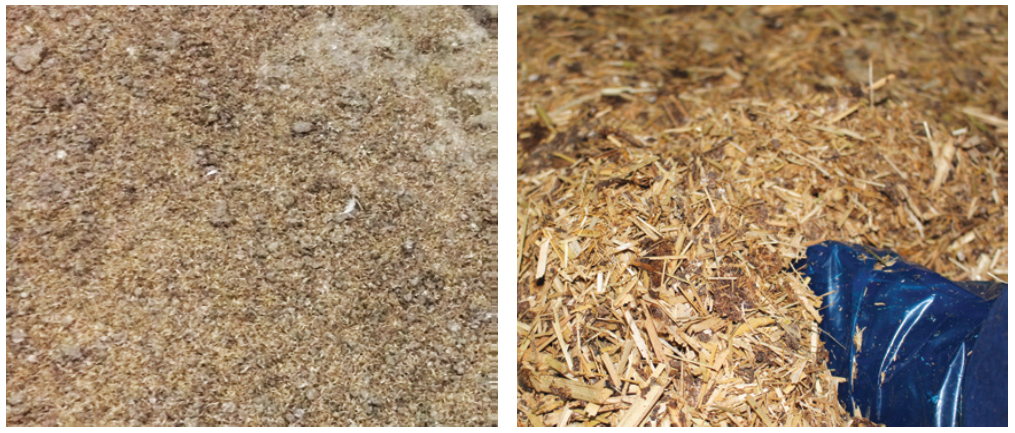Collett (2012) described wet litter as when litter moisture exceeds 250g/kg (25% moisture content on a wet basis). When this moisture level is exceeded, litter cushioning ability, insulating properties and water holding capacity begin to be compromised. Collett (2007) described the cause of wet litter as being when the rate of water addition (e.g. excreta, spillage, condensation, leaks) exceeded the rate of removal through evaporation.
Another important term commonly used to describe desirable litter condition is friable. The word friable means “to crumble”. An easy method to assess if a litter is in the ideal state of friable is to form a ball of litter in your hand. When you open your hand, it should easily crumble (fall apart). The litter is too wet if the ball stays intact (likely >30–35% moisture content). Conversely, the litter is too dry if it is dusty (<10% moisture content).
A method to assess if litter is in the ideal state (friable), is to form a ball of litter in your hand. When you open your hand, it should easily crumble (fall apart), but not be dusty.

Dunlop et al., (2016) summarised the importance of litter condition, as it will influence how chickens interact with and work (scratch, dig and forage) litter and affects litter drying rate. DAF Queensland also have an assessment guide that contains detailed instructions and photographs on assessing litter conditions, as well as management strategies and corrective actions. The guide uses a 3 x 3 matrix that assesses the moisture in the litter (dry, moist or wet) against its friability (friable, clumping or caked). A scoring system of 1–5 is used to assess the litter, with a score above 2 requiring corrective action.
Table 3 shows the scoring system and some of the management strategies from the guide.
The aim should always be to maintain the litter in a friable state and not wet to avoid the formation of clumps and cake. This will aid in the transfer of moisture from the litter to then be ventilated from sheds.
Table 3. Litter condition assessment guide (adapted from AgriFutures Australia and Department of Agriculture and Fisheries, 2019)
| Description | Score | Assessment and actions |
|---|---|---|
| Dry and friable | 1 | Flows freely through the fingers and will fall apart after being squeezed. No action required provided it is not causing dust problems. If dust issues, condition to homogenise with moister material. |
| Moist and friable | 2 | Can be darker and inconsistent in colour in the litter profile. May require litter conditioning to improve consistency. |
| Dry and clumping | 2 | Clods are seen when moving foot through the litter. Chicken activity may move clods around but will not break them up. May require litter conditioning to improve friability. |
| Wet and friable | 3 | Chicken activity will tend to compact the surface rather than work the litter. Will require ventilation to remove excess moisture as it will compact quickly. |
| Moist and clumping | 3 | Large clods or clumps of litter starting to form. Prone to caking, so will require corrective actions such as conditioning, additional ventilation and heating. |
| Dry and caked | 3 | Distinct capped or crusted surface. Can often see a distinct ridge line between the cake and dry friable litter. Will require mechanical conditioning to break the cake, as chicken excreta will remain on the surface. Will likely require additional ventilation to remove ammonia that is released. |
| Moist and caked | 4 | Litter lifts as large sheets of cake as foot moves through the litter. Caked litter will feel soft and spongy under foot. Will require mechanical conditioning to break the cake. Will also require additional ventilation to remove ammonia that is released. |
| Wet and clumping | 4 | Clumps or clods are visible in the litter and starting to form a thin layer of cake. Will require corrective action that includes adding dry friable litter to absorb moisture, as well as mechanical conditioning and ventilation to remove moisture and ammonia. |
| Wet and caked | 5 | Visibly wet and can look muddy. Will require immediate corrective action that includes adding dry friable litter to absorb moisture, as well as mechanical conditioning and ventilation. This litter may require removal and replacement with dry litter if the condition cannot be rectified. |

